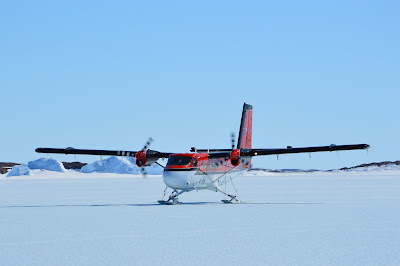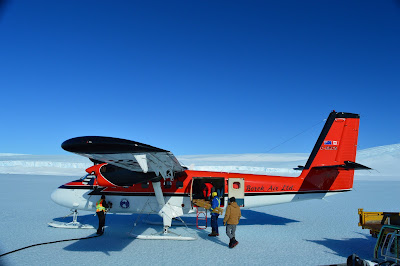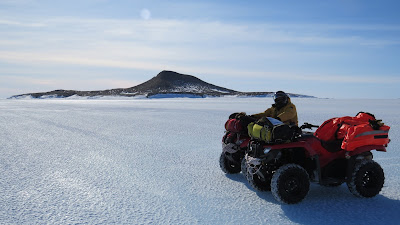Get comfortable, maybe even grab a cuppa. This is a very lengthy but worthwhile read (in my opinion anyway).
 |
| On our way. A brief stop for lunch at Jelbart Glacier. (Photo credit: Angus Cummings). |
The most distant outpost encompassed by our station is Ledinghams Depot. Situated in the Stillwell Hills area it is approximately 150 kilometres west of Mawson Station, and is visited most years only to carry out maintenance. In saying that, there were no visits from 2010 to 2014. The depot was named after Rod Ledingham, who was a very successful and greatly respected geologist and field training officer with the Division many years ago, and has life long connections with Antarctica, having first worked as a meteorologist with the British in 1966.
 |
| The view over Ledinghams Depot (Photo credit: Angus Cummings) |
This year I had the incredibly good fortune to be selected as one of the six from our ANARE (pronounced "a-nah-ree", Australian National Antarctic Research Expedition) to participate in a five day sea ice traverse to carry out a hut inspection and undertake some gas fitting work. In all honesty I really wasn't looking forward to the trip. 150kms across the ice is a long way, and when I refer to ice, it is in fact sea ice, but is largely covered with compacted sastrugi (snow which has blown into wave like bumps by the high winds we get here), which makes for a very uncomfortable slow journey. However, despite my reluctance I knew the positives would outweigh the negatives (with the right attitude I think they always do).
So it was that after two to three months of planning, field safety training refreshers, and meticulous organisation we set off in two Hagglunds early on Monday morning, September 21. We had waited all month for the weather to line up five to six perfect days, and when a good week finally arrived we were ready to go.
The first leg of the journey was to end at Colbeck Hut, in the Colbeck Archipelago. This is approximately 90kms from Mawson, and to get there we travelled around a number of glacier tongues. Some of these glaciers are huge and left me in awe of their majesty. Each one is different to the next. Some are incredibly wide and don't protrude out from the coast as far as you'd expect, whereas some are breathtakingly rugged, broken, and finish in the most spectacular formations advancing miles out to sea. The colours in parts of the walls would have to be the most beautiful deep blues that nature can produce. They are truly spectacular.
 |
| A section of the very rugged and broken Taylor Glacier. |
Along the way we encountered a number of seals lazing around tide cracks close to the coast or a glacier, often accompanied by emperor penguins. Proof again for me that emperors enjoy the company of other creatures. Often around glacier tongues we crossed a number of large tide cracks, which had to be assessed before we drove over them. Tide cracks are sometimes undermined and therefore the ice on the edges can be unstable and may collapse when driven on. Hagglunds have been claimed before by these as a result of lack of caution. At a cost of several hundred thousand dollars for a Hagg, the Division goes to great lengths to educate us in the correct precautions to take. Also important to remember is that Haggs are now only built for military use, so in effect are irreplaceable.
 |
| Tide Crack!! |
 |
A berg broken off the end of Jelbart Glacier, tide crack in the foreground.
|
Finally after six or so hours we arrived at Colbeck Hut and set about preparing our home for the night. Colbeck is sited on an island, which is locked in sea ice most of the year. It is yet another beautifully peaceful location. As I've mentioned before one of the most enjoyable things I find when in these remote locations is the absolute quiet. Here you only need to walk for five minutes and you can be completely alone and away from other peoples noise. I could literally sit forever and just enjoy the silence. It is something I will miss incredibly when I leave. As well as the peace, the surrounding islands and ice add to the picture. It's impossible for me to describe how these things combine to make me feel. I can only say it promotes absolute calm within. Something I don't experience very often.
 |
| Looking back toward Colbeck Hut and the RMIT van. |
After a good nights sleep we set off early on Tuesday bound for Stillwell Hills. A detour to Tilley Nunatak (an Inuit word for an isolated peak of rock protruding from ice or snow) had been scheduled to check the condition of a small fuel cache. When we arrived we had to battle a very isolated katabatic wind of about forty to fifty knots around the Nunatak. So isolated that only a few hundred meters either side the wind was minimal. It's probably hard to comprehend if you haven't experienced it but Antarctica is like that. Many times we have been on station and had virtually no wind, yet a kilometer or so either side you can see snow blowing off the plateau at what looks like one hell of a rate of knots.
 |
| Tilley Nunatak (Photo credit: Angus Cummings). |
Despite the wind Tilley was a very picturesque place, and I was disappointed we were unable to spend enough time there to have a good look around. The fuel cache turned out to be two jerry cans of ATK (aviation turbine kerosene?), and I was left unsure of the point in having such a small amount of fuel as an emergency supply when the distance to safety is so great. I guess someone thought it was a good idea.
After fifty kilometres or so we entered the Stillwell Hills area, which was yet another breath taking vista. Maybe the reason the area seems so beautiful is because so much of what we see around station is just ice plateau. I'm not completely sure, but approaching the area you are suddenly surrounded by distant islands, ice bergs, and exposed rocky hills and headlands. Again, words don't do it justice and I'll never be able to describe how much the scene pleased my eyes.
 |
| Looking toward Stillwell Hills from William Scoresby Bay. |
Ten kilometres later we arrived at the depot and were pleasantly surprised by the hut. It was my understanding that the hut was small and that we would be spending our nights in a polar pyramid (a pyramid shaped tent designed to withstand a blizzard). I was wrong. The hut is an extended "Apple" (a round fibreglass structure which deconstructs into separate panels, making it easy to ship to the continent, and consequently transport to site and erect). This type of shelter was pioneered by Ledingham himself, so it is fitting that the largest form of it we have is erected at the site named after him. In this case the "Apple" is in fact a "Zuchini", as it has four straight sided panels fitted to the middle to extend it. It was large enough for five of us to sleep in, three on narrow bed settee type arrangements, and two others on squabs on the floor. Our trip leader J.B. (who I've mentioned in previous blogs) slept outside in his bivvy, as he always does.
 |
| "The Zuchini" (Photo credit: Pete Layt). |
We had arrived early enough in the afternoon to get a head start on the work that we had to do, and in no time I had installed a new gas regulator, tested the pipework and completed a general inspection of the installation. Little Pete, our electrician found that what he had been told needed doing in fact didn't, so had given me a hand. Big Pete, our chippie started removing old silicone from the joints between the panels with a little help from J.B. and Angus (normally our station Met Tech, but in this case one of our two tourists on the trip, the other being Paul who is one of our diesos who had come in case we had mechanical troubles, but ended up driving for a bit.). Soon enough it was knock off time and a few of us wandered off to briefly explore the nearby surrounds. Others sat in the hut.
 |
| Fjord type inlet just over the hill from Ledinghams Depot. |
Day two (Wednesday) at Ledinghams dawned true to forecast. Calm, sunny and warm (-14 degrees), what more could you ask for in such a wonderful place. Our plan for the day had been decided the evening before, so we all chipped in to assist Big Pete with the remaining task of stripping out the old silicone from the panel joints so he could finish earlier and we could all spend the best part of the day exploring the region in the Haggs in search of the Fold Island emperor colony.
We spent a number of hours driving around the islands, stopping to take photo's of various bergs and ice formations until we finally located the penguins. We had decided earlier that if we found the penguins we would not approach too closely due to the fact that this colony is undisturbed by humans normally unlike our regular haunt of Auster. Ironically we ended up right in the path of the birds that were transiting to and from the colony, and they seemed as curious as their cousins at Auster so I'm not sure that our caution was called for.
 |
| The distant Fold Island emperor colony. |
However it did demonstrate our policy of leaving the Antarctic as undisturbed as we possibly can, which I believe is a very important philosophy to live by. Along the way we came across the most intense and colourful collection of small jade "growlers". These are rarely seen very small bergs, formed from incredibly clear green water that resemble large chunks of pounamu. They are spectacular to look at from a distance, and even better when you are standing right next to them. Many photo's were taken and a couple were climbed (they were relatively small).
 |
| Small jade berg "wave". |
We returned to the hut late in the afternoon in time to spend some more time wandering around the local area climbing various hills to take in the expansive views. It always amazes me how far you can see from a high point here. Because of the lack of air pollution you can literally see for miles so bergs that may be fifty miles out to sea are clearly visible through a zoom lens or binoculars.
Before long it was time to return to the hut to prepare dinner and settle in for the night, in preparation for the return leg to Colbeck. Our chef back on station had prepared a whole lot of meals for our trip and vacuum packed them so basically all I had to do each night was thaw them in hot water and heat them in a pot. The most I did was boil the rice, pasta, or mix instant "real" mashed potatoes (which is surprisingly good). Awesome work Kim, it was greatly appreciated.
 |
| The crew inside the Ledinghams Zuchini (Photo credit: Pete Layt) |
After an early start the next day we headed away from Ledinghams bound for Colbeck. It was a quiet journey for the first hour or so. I'm not sure if it was because the other two were taking in the scenery again or not, but personally I was a bit sombre knowing that in all reality, I will never have the opportunity to see this beautiful part of Antarctica again. Maybe if I was given the opportunity to come back to Mawson for a winter again it would happen, but having had the privilege of visiting Stillwell Hills I think I would probably encourage my counterpart on station to take the opportunity if they hadn't had the chance before. It would be selfish doing otherwise. On reflection I know I have achieved a number of "firsts and lasts" this year and I have been incredibly fortunate.
The highlight of the journey from Ledingham to Colbeck was a mid-day stop at Proclamation Point. This is the spot that in 1931 Sir Douglas Mawson staked his claim to the part of Antarctica that is now recognised as Australian Territory. He was the leader of a joint British, Australian and New Zealand (BANZARE) expedition at the time so the visit had real significance not just to my Aussie mates, but myself as well. Once we'd had time to reflect on the differences between the way we explore the region compared to Dougie, and also had a bite to eat we continued on with our journey.
 |
The original claim erected by Douglas Mawson
in 1931. It was lost and then rediscovered in the
1950's by expeditioners visiting the site. |
Next stop was beside Taylor Glacier, close to Taylor Rookery. Four of the party walked the three kilometres to get within one kilometre of the rookery. I declined as I couldn't really understand the attraction considering I can have them walk right up to me at Auster. Instead I hung around the Hagg and was entertained by passing emperors who often stopped to spend some time observing me before they continued on their trek to a distant tide crack or the open sea.
We finally arrived at Colbeck Hut for the second time and set about making our home for the night. Being very tired from the days travel it was an early night for all of us, knowing we had another ninety odd kilometres to go until we reached Mawson again.
Again the next day we had an early start. The plan was to arrive back on station early enough to unpack the Haggs and redistribute all our gear to the correct locations, fuel up and park away the Haggs in time for a pre dinner beer and brag session with our mates that had remained on station for the week. Along the way we detoured to visit and photograph a very big jade berg that was discovered earlier in the winter. This was an absolute sight to see. The colour of these things is really beautiful, and as I said before it was such a pleasure to be able to get right up next to it. It is a sight I will remember for a long time.
 |
| Majestic jade berg. |
Another strange occurrence during the Colbeck-Mawson leg happened around midday. Looking toward the north you could see what appeared to be expansive ice cliffs which were in fact a mirage. I had seen mirages here before but not to the extent of this one. If you didn't know better you'd have thought you were surrounded by distant cliffs. Photo's were taken and to my surprise showed the vista clearly.
 |
| The ice cliffs that appear real but don't exist. |
We finally arrived back at Mawson around 2.30pm in a lot quicker time than the outward trip. The sled we were towing behind our Hagg for the first leg to Colbeck had compressed the snow on the way out, so following our tracks from five days earlier made the travelling a lot smoother, and therefore quicker. A stop on the sea ice just before we entered Horseshoe Harbour to shake hands and thank each other for a successful and safe trip was a nice touch instigated by our trip leader J.B.
Before we knew it all our gear was unpacked and I was enjoying my first hot shower for five days. Then it was off to the bar to catch up on the weeks news and tell everyone about our week.
This trip will probably be remembered as the highlight of my year. The penguins at Auster would have to be a close second, but the fact that even fewer people have had the opportunity to visit the Stillwell Hills area made it so much more special to me and a memory I will remember for a long, long time. I have to say I am incredibly grateful for having been given the chance to be a part of the trip.
 |
| The Ledinghams Traverse Party. We knocked the bastard off! |
Thanks go to my fellow traverse crew, J.B. (John Burgess, FTO and Trip leader), Big Pete (Pete Layt, chippie, BSS, and therefore my immediate boss on station, not that you'd know it by the freedom he gives us), Little Pete (Peter Lecompte, sparky, and my room mate in Hobart), Angus Cummings (Met Tech, trip trades assistant and the youngest on station), and Paul Amos (dieso, and in effect a Ledingham tourist as he didn't do a lot other than drive). It was an absolute pleasure to be a part of the trip with you all.

















































